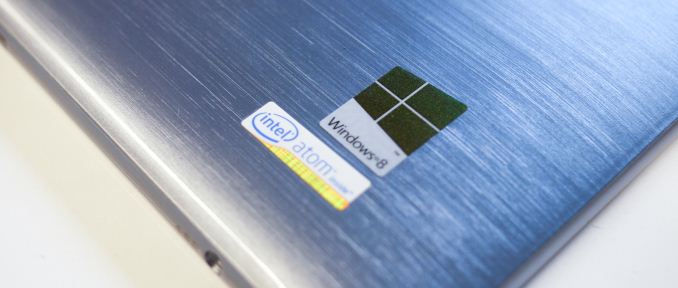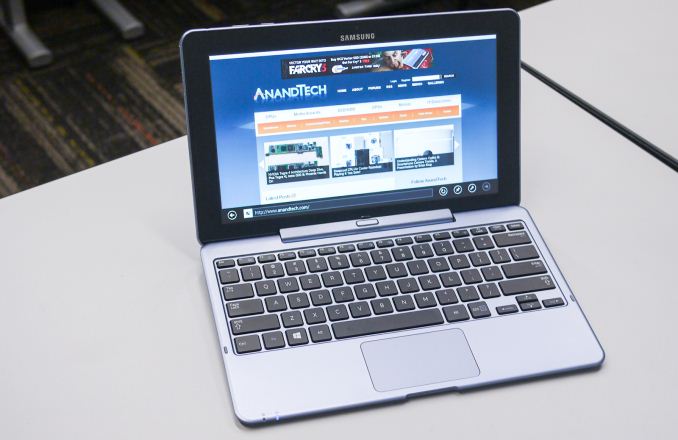Samsung ATIV Smart PC: Revisiting Clover Trail Convertibles
by Vivek Gowri on March 18, 2013 12:00 AM ESTConcluding on Clover Trail for Windows
I used the ATIV Smart PC as my main system on the CES show floor. It worked out relatively well, though part of that was due to the fact that I didn’t actually spend much time using it there. My CES scheduling this year ended up in back-to-back-to-back meetings for a large portion of my three days there. Much of my writing ended up being done back in the hotel room where I had my trusty Samsung Series 7 Chronos to rely on. But honestly, the ATIV was pretty solid. I had relatively modest expectations for it on the way in—“last all day, give me a solid writing tool, and run Lightroom so I can publish decent posts on the go.” That’s what I said I wanted out of it in the CES gear article I posted in Pipeline the day I left, and the ATIV did all I asked of it with nary a complaint or hiccup in the process.
As I type this, my roommate is sitting behind me playing StarCraft II on the ATIV Smart PC, albeit rather slowly. And honestly, that’s the story for me with Clover Trail. You really get the best of both worlds with regards to PC application compatibility and battery life. Performance, at times, can be a bit pokey, particularly on the GPU side of things. But Clover Trail really brings all day computing to the world of x86 tablet PCs. It isn’t the fastest or most interesting SoC in the world. But in a mobile companion, if having 10 hours of battery life matters, you cannot beat the Clover Trail/Windows 8 combination as a tablet platform. It’s just so much more versatile than iOS or Android in terms of replacing a small notebook, and when you factor in the battery life parity that we see in Clover Trail, that’s a legitimately valuable proposition.
Just based on pricing, it becomes quickly evident that the Atom-based tablets offering the best value right now are the ATIV Smart PC and ASUS’ VivoTab Smart. You can get either in 64GB form in the $500-550 range, making them cheaper than most Windows RT devices offering equal amounts of storage space (though it’s worth mentioning that you can get a VivoTab RT for less than $400 pretty readily). As a value proposition, you have to think about it—would you rather pay $499 for a 16GB iPad, a 32GB Nexus 10, or a full fledged Windows Tablet PC with ~35GB of unused storage space? Put in terms like that, it’s pretty awesome.
The ATIV Smart PC is a decent tablet, and taken on its own it’s a good device. But there are some really key missteps that were made with the hardware—design, build quality, and display. Given the cost and overall usability of the device, it’s possible to overlook these flaws, but the comparison to the VivoTab Smart is where the ATIV Smart PC starts to fall down. The ASUS has a nicer 10.1” form factor with a better display, along with better styling and build quality. The ATIV does have one trump card—the active digitizer. Other than that, the 10.1” VivoTab Smart is just a better piece of hardware, more elegant and nicer to use. Honestly, unless you really want the Wacom digitizer, you’re better off going the direction of the ASUS.












59 Comments
View All Comments
Krysto - Monday, March 18, 2013 - link
Why do Clover Trail devices need to be "revisited" every couple of months? Does Intel need Anandtech to do their PR for them?BrokenCrayons - Monday, March 18, 2013 - link
Though the internal hardware and performance expectations aren't going to change until there are improvements made to the silicon, the hardware package in which it resides that includes the case, screen, interface options, and battery along with other odds and ends make devices themselves worth a look. Samsung, in this case, is different with respect to build quality that is something of a shortcoming.That aside, Clover Trail is pretty uninteresting as a platform outside of putting it in the perspective of battery life. Priced at over $700, I don't personally see the appeal of what is, in essence, a netbook that costs over double the price when compared to budget-friendly systems of only a few years ago. There's just not enough benefit to offset the cost increase over a bargin bin AMD C-60 or last-gen Atom netbook for which I can simply carry an additional battery. if I want endurance as I'd be the sort to leave the keyboard dock forever attached and rarely bother to touch the screen.
Pirks - Monday, March 18, 2013 - link
Why are you lying about Clover Trail tablet prices being over $700 when in fact they start at $479?See this as a proof: http://www.newegg.com/Product/Product.aspx?Item=N8... and this too: http://www.newegg.com/Product/Product.aspx?Item=N8...
Are you a Google and/or Apple fanatic by any chance? Just curious ;)
BrokenCrayons - Tuesday, March 19, 2013 - link
From the first page of the article:"Clover Trail meant good battery life and x86 compatibility, the inclusion of Wacom active digitizers were exciting, and the 11.6” PLS/S-IPS displays seemed promising. The two are very comparable devices, though the ASUS is priced higher at $799, and doesn’t include the laptop dock anymore (it did at launch.) That gives the Samsung a pretty sizable price advantage, as $749 is only about $50 more than the 64GB Windows RT tablets when the keyboard accessory cost is included—more than worth it given the disparity in features and capability."
Death666Angel - Tuesday, March 19, 2013 - link
You realize that you are talking about all Clover Trail tablets, while Vivek just talks about 2 very specific, premium products? If you don't need a keyboard dock and an active digitizer, you can get Clover Trail tablets much cheaper. And in turn, if you need a keyboard dock and especially an active digitizer, comparing that price with old netbooks is useless, as they are useless for that specific need.BrokenCrayons - Tuesday, March 19, 2013 - link
The scope of my original post and response do not encompass, as you imply, "all Clover Trail tablets" outside of considerations of overall platform performance. The majority of the discourse concerns the Samsung tablet in specific and its various shortcomings relative to the MSRP under consideration of the benefits offered in exchange for the costs.With regards to my needs for a various features such as an active digitizer, I've already mentioned that previously. "I'd be the sort to leave the keyboard dock forever attached and rarely bother to touch the screen." In light of my own usage model and requirements, the price of the Samsung isn't justified or reasonable when one can acquire similar performance from low cost hardware available at office supply stores.
http://www.officedepot.com/a/products/592409/Acer-...
Understandably, your personal preferences and desires for a computing platform might be different. That's perfectly reasonable, but the mold which suits your needs may not be universally applied to others.
Death666Angel - Tuesday, March 19, 2013 - link
Then you should amend that sentence:"That aside, Clover Trail is pretty uninteresting as a platform outside of putting it in the perspective of battery life. Priced at over $700, I don't personally see the appeal of what is, in essence, a netbook that costs over double the price when compared to budget-friendly systems of only a few years ago."
As you make no effort to distinguish between different CT platforms. And when you get called out for it, you quote the article which just mentions 2 examples.
duploxxx - Monday, March 18, 2013 - link
typical OEM behavior, go with the flow i.s.o. design to differentiate. There has always been a netbook atom killer called Brazos, same for the tablet space it exists, http://www.anandtech.com/show/6672/vizio-tablet-pc... no slugish gui or impossible 3d like on the clovers, i had many tabs in house for testing, just makes the all day experience horrible. from an smooth workable gui experience (swiping between screens, switching applications) on tablets: IOS > ANDROID = AMD Soc >>>>> Clover this is how you can rate the experience.nerd1 - Monday, March 18, 2013 - link
I don't care about UI experience, I do care about the active digitizer (for inking) and battery life.DanNeely - Monday, March 18, 2013 - link
The part of the Asus device chaos that's annoying me the most is that from what I can tell from their webpage; their 10" atom model is only available with a wireless keyboard and a cover that can be folded up to let the two imitate a laptop on a table while the winRT model has an actual keyboard dock with the extended battery and ability to use like a laptop even if a perfectly flat surface isn't available. The atom tablet and keydock would otherwise match what I am looking for almost perfectly.